How to Make Fresh Homemade Ciabatta Bread
This post may contain affiliate links. Please read my disclosure policy.
This post will teach you how to make a crusty, open-crumbed loaf of ciabatta bread. Below you will find a detailed guide full of tips and tricks as well as a troubleshooting section with answers to FAQs to help you make a loaf of ciabatta bread with a crisp, golden exterior, and a light, airy crumb. Video guidance, too!
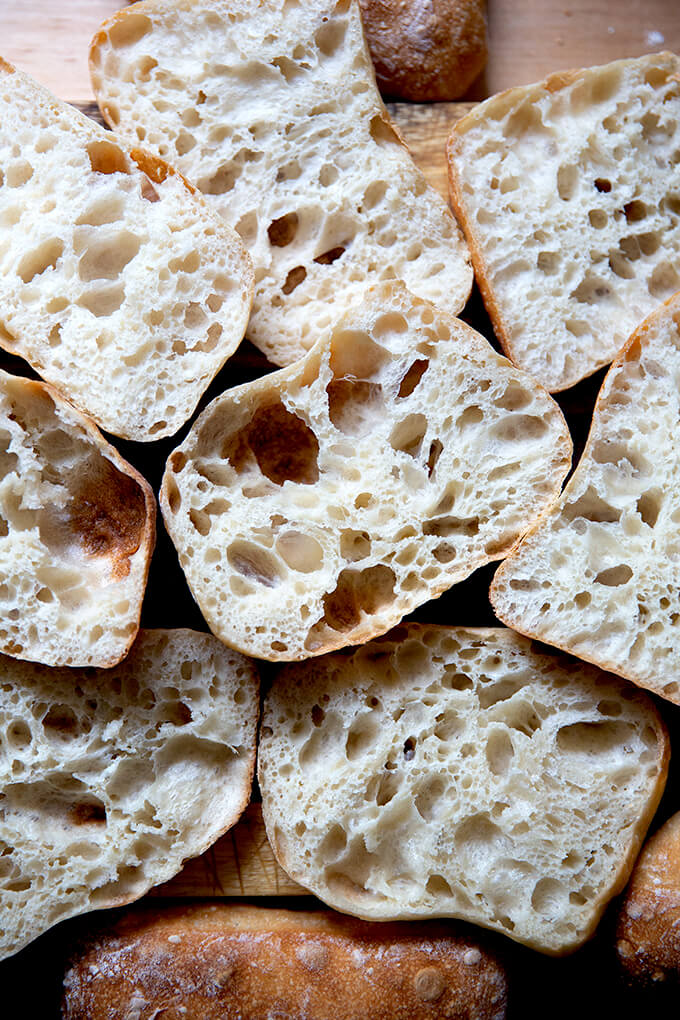
Friends, today I have a saga to share with you, one that fortunately ends happily: with a crusty, open-crumbed loaf of ciabatta bread, the recipe for which I hope you make soon and then all summer long, for beach lunches and mountain hikes, for dinner with friends and family, perhaps beside a fire or under twinkling bulbs strung from tree to tree, a pool of olive oil at the ready to dunk into at will. This has become one of my favorite homemade bread recipes.
Grab a cup of tea, let’s start from the top …
After posting this sourdough ciabatta bread recipe in April, I felt determined to make a comparable, yeast-leavened variation. For reasons I cannot explain, when I revisited a recipe I had posted here years ago, the photos for which looked promising, I couldn’t get it to work quite as well. The rolls, while tasty, had a tight, closed crumb, not as light or as open as I remembered (or as pictured).
In search of that more wild, amorphous crumb, which ciabatta is known for, I turned to my various bread baking books, namely The Bread Baker’s Apprentice, which noted that ciabatta often is made with a poolish or biga, meaning a small amount of flour and water mixed with a leavening agent and left to ferment for a short period of time.
This got me thinking: could I replace the 100 grams of sourdough starter in the sourdough ciabatta recipe with 100 grams of poolish? I gave it a go, stirring together 50 grams each flour and water with 1/2 teaspoon instant yeast and then letting it sit for three hours. When the surface of the poolish was dimpled with holes, I proceeded with the recipe, adding water, salt, and flour; mixing the dough; stretching and folding it; letting it rise, and finally transferring it to the fridge overnight.
The following morning, I turned the dough out onto a floured work surface, cut it into eight portions, and transferred them to a sheet pan. One hour later, I baked them.
Friends! It worked beautifully. The crumb, while not quite as honeycombed as the sourdough version, was full of holes, giving the ciabatta its characteristic lightness and airiness. I felt really good about the recipe — it was simple enough, nearly identical to the sourdough version without having to use a sourdough starter, and very tasty.
I almost posted the recipe but anticipating that some people might want a loaf of ciabatta as opposed to rolls, I decided to test the recipe in loaf form.
This is where the saga begins. The two loaves I pulled from the oven, while crusty and beautiful from the exterior, were … HOLLOW! I had baked, in essence, two gigantic pita breads, perfect for housing torpedo-sized falafel. (Stay tuned … the saga continues! Kidding.)
This experience sent me on a tear to figure out where I went wrong. As I read about “tunneling”, I tried many things to fix the situation — lowering the hydration, increasing the hydration, kneading the dough, lowering the oven temperature, decreasing the amount of yeast, eliminating the cold proof — and in the process, I made many many loaves of hollow ciabatta. At the risk of sounding a little dramatic, this quest paralyzed me creatively — truly: without this ciabatta puzzle solved, I couldn’t create a single new recipe for the blog.
In the end, after doing a bit more digging, the fix was simple: to lengthen the final proof. Whereas the sourdough ciabatta can rest at room temperature for only an hour before baking; the yeasted ciabatta — at least in loaf form — needs much more time, more like 2 to 2.5 hours.
Why? Because, as I’ve learned, when under-proofed dough enters an oven, the yeast has lots of remaining energy, which leads to fast and furious gas production. This explosion of gas breaks the structure of the bread, causing the tunnel to form.
As soon as I extended that room-temperature proof, the tunnels, thankfully, vanished.
Friends, if I’m being honest, it is not without trepidation that I post this recipe. As I type, I have two bowls of ciabatta dough rising — just to be sure! I have made more ciabatta these past two months than any other bread I think ever (with the exception, of course, of my mother’s peasant bread), and though I am now consistently met with great results — with loaves that emerge from the oven flour-dusted, golden-crusted with both a chewy and light, porous texture — I still worry. Those hollow loaves haunt me.
As you can see, I’m a bit anxious for you all to give this recipe a try. My wish, as noted at the start, is for this to become your summer dinner bread, your trusty swiper for all those delicious, oily, corn-studded, tomato-infused, basil-specked dregs. They deserve it.
If you give it a go, please let me know how it turns out.
PS: Foolproof Pita Bread Recipe
PPS: Overnight Refrigerator Focaccia = The Best Focaccia
Traditional Ciabatta: An Overview
Let’s review what ciabatta is:
- Traditional ciabatta is characterized by a slipper shape as well as an extremely porous and chewy texture. Originating from the Lake Como region of northern Italy, ciabatta means “slipper” in Italian.
- Ciabatta dough is wet and sticky with hydration levels often 80% or higher. Both the recipe below and this sourdough version are 82% hydration. (If you are unfamiliar: To calculate hydration percentage, simply divide the weight of the water by the weight of the flour; then multiply it by 100. In this recipe, that’s 410/500=0.82 | 0.82 x 100 = 82%)
- Traditional ciabatta recipes call for very little yeast and a long, slow rise. Many recipes call for making a biga or poolish (as noted above), which helps produce that light, airy texture.
- Some ciabatta recipes call for milk or olive oil, but neither of these ingredients is required to make a traditional loaf of ciabatta.
And let’s review what ciabatta isn’t:
- Shaped! In the ciabatta bread recipe in Jeffrey Hamelman’s Bread, he notes: “There is no preshaping or final shaping—once divided, the dough is simply placed onto a floured work surface for its final proofing.” With the sourdough ciabatta bread recipe, I follow this no-shaping rule. In this yeasted recipe, I deviate! After a number of experiments, I prefer doing a pre-shape — it’s counterintuitive but I actually get a more open crumb when I preshape the dough. That said, for ciabatta rolls, I stick to the no-shaping rule — it’s nice not having to ball up 8 portions of dough. (Of course, you can experiment and see which method you like best.)
- Scored! Unlike other crusty loaves of bread, ciabatta is not scored.
Troubleshooting
If your dough does not cooperate the first time around, you may need to make some changes:
- Water: This is a very high-hydration dough, and depending on the flour you are using and your environment (if you live in a humid environment, for instance), you may need to reduce the amount of water. If, for example, when doing your stretches and folds, the dough never came together in a cohesive ball, I would reduce the water by 50 to 60 grams next time around.
- Flour: All flours absorb water differently. Through troubleshooting with people all over the world often with people making this sourdough pizza recipe, this yeast-leavened pizza recipe, and most recently this sourdough ciabatta recipe, the type of flour being used plays a critical role in how the dough turns out. Often the water needs to be reduced considerably for the dough to come together. If you live abroad or in Canada, you can either make the recipe once as written or add the water slowly, mixing as you do, until the dough resembles the dough in the video.
- Shaping: Because this is such a wet dough, shaping may be tricky. I have smooth, wooden countertops (there’s some sort of sealant on top) that work nicely for shaping, and I imagine granite and marble would work well, too. My mother loves her Roul’ Pat for shaping. All of this is to say, if you are having trouble shaping, the surface you are shaping on could be playing a role.
How to Make Ciabatta Bread, Step by Step
The first step of the recipe calls for making the poolish. To do so, gather your ingredients: flour, water, and instant yeast. SAF is my preference.
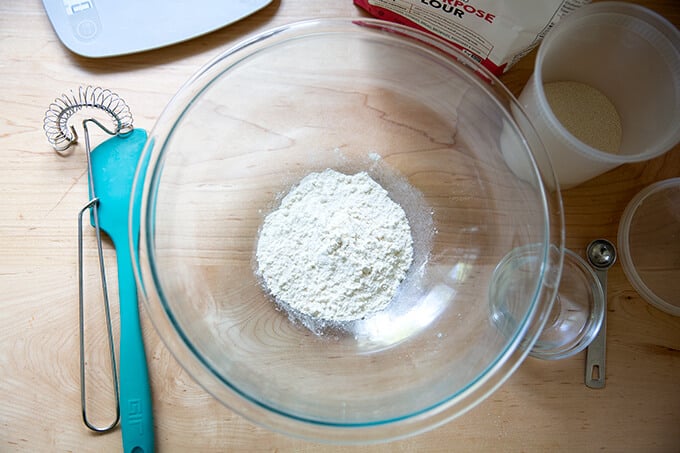
Whisk together 50 grams flour and 1/2 teaspoon instant yeast.
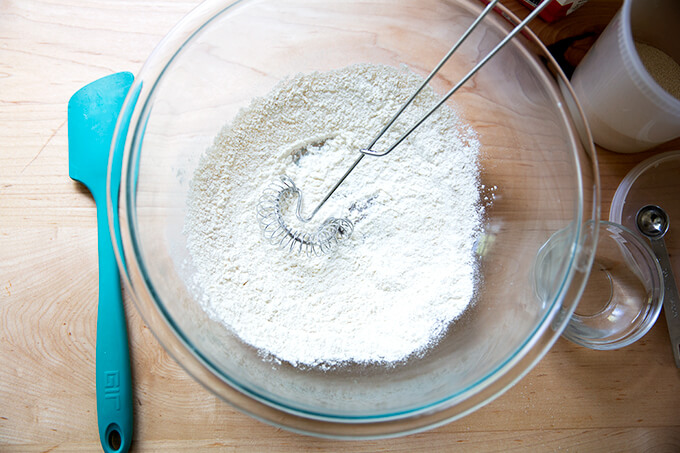
Add 50 grams water.
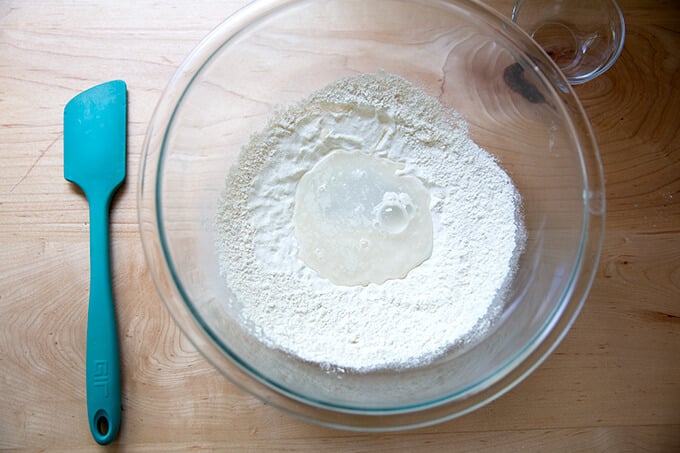
Stir to combine. Cover the bowl and let sit for 3 to 4 hours or until…
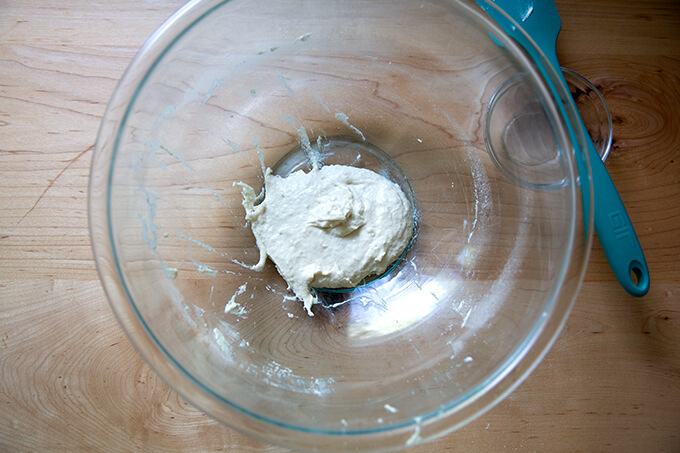
… the surface of the dough is dimpled with air pockets.
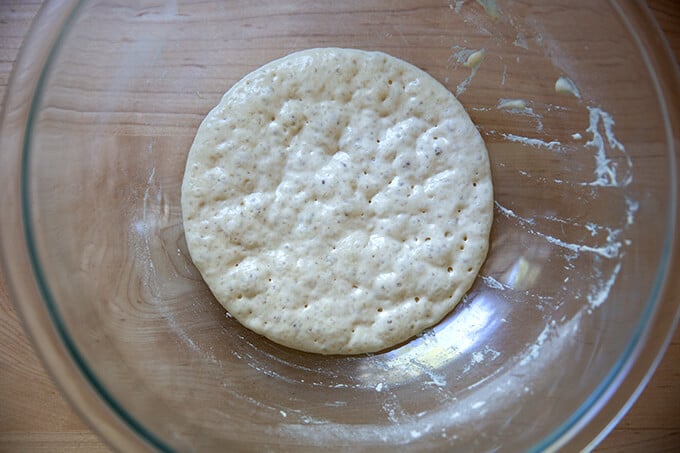
Add 360 grams water. (This part is really fun … the poolish bubbles up as a unit and floats on top of the water… it really feels alive!)
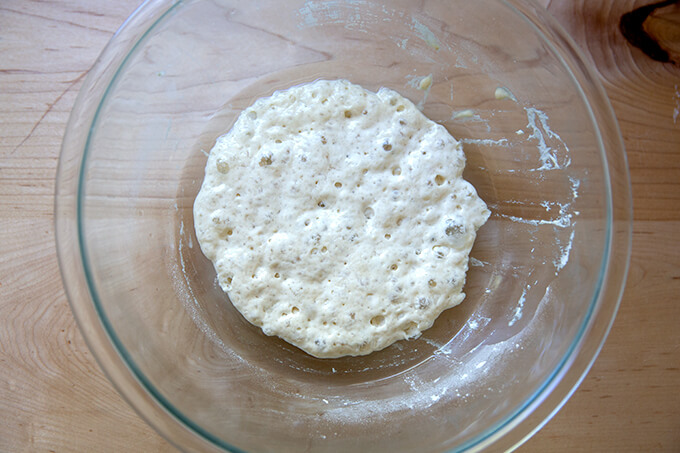
Stir to combine; then add 12 grams salt and stir again to combine.
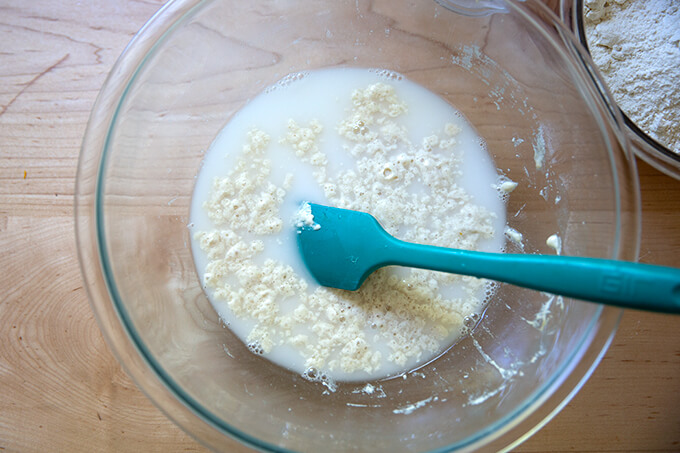
Add 450 grams flour, preferably bread flour.
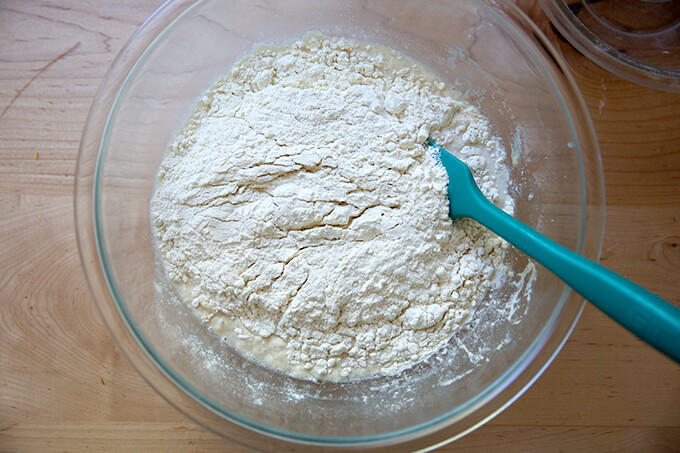
Using a spatula, stir until you have a sticky dough ball. Cover and set aside for 30 minutes.
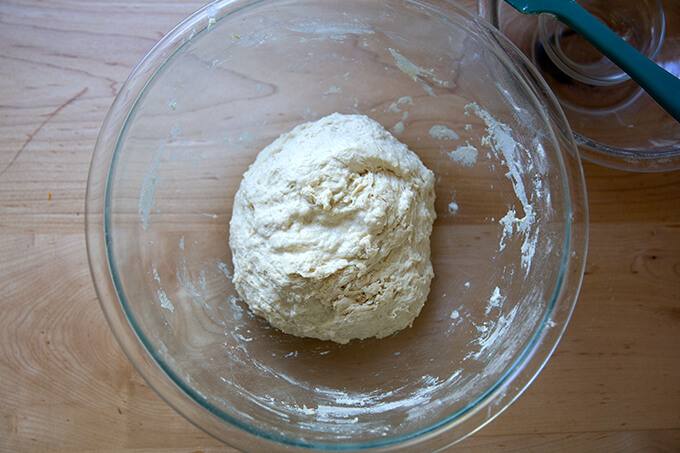
With wet hands, perform a set of stretches and folds, by grabbing one side of the dough, and pulling it up and to the center. Rotate the bowl a quarter turn, and repeat the grabbing and pulling. Do this until you’ve made a full circle. (Watch the video for more guidance. I employ a sort of “slap and fold” technique, which is helpful with this very wet dough.) Cover the bowl.
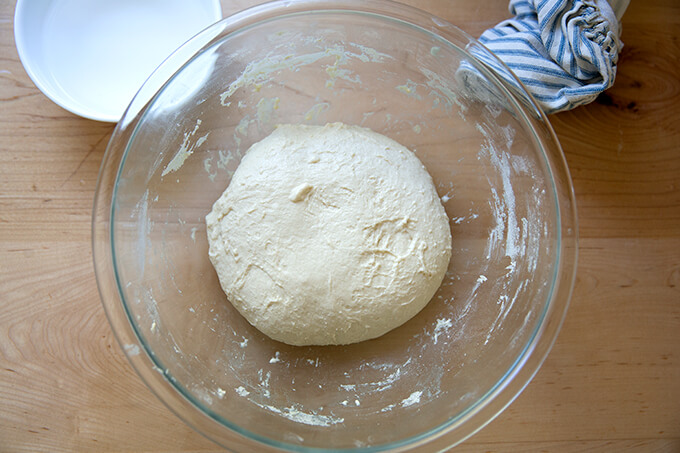
Thirty minutes later, repeat the stretching and folding.
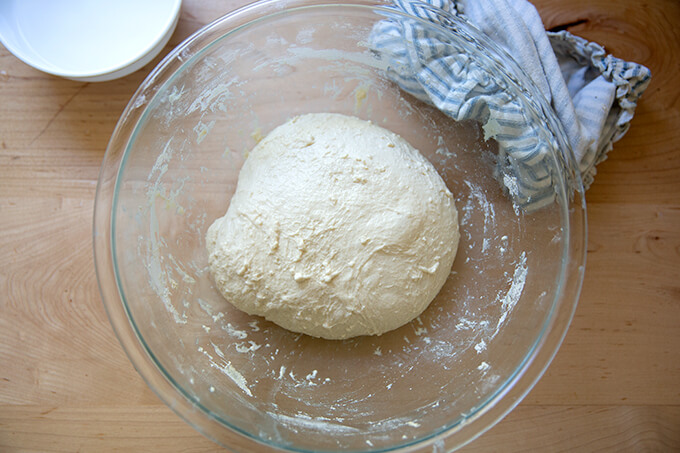
If time permits, repeat this stretching and folding twice more at 30-minute intervals. This is what the dough looks like after the third set of stretches and folds:
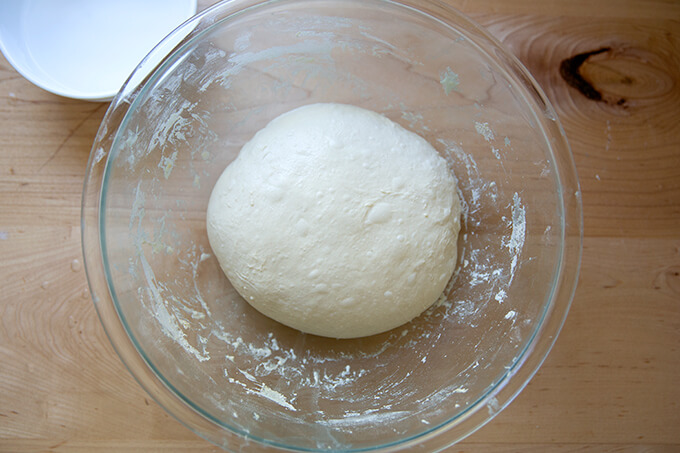
This is what the dough looks like after the 4th set. Feeling the dough transform from a sticky dough ball to a smooth and elastic one is really cool.
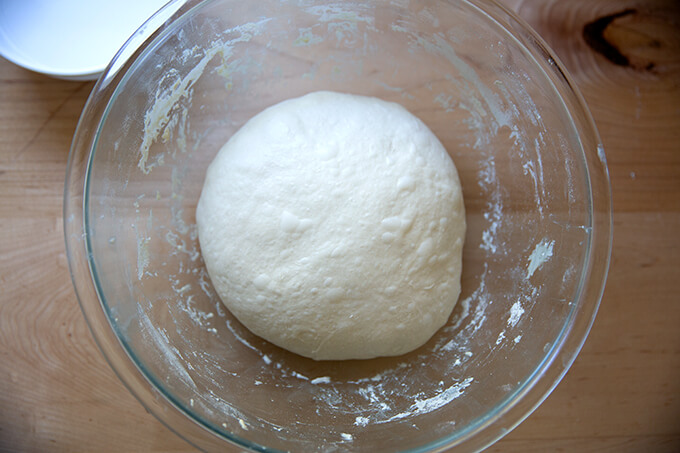
Transfer the dough to a straight-sided vessel and let it rise at room temperature until…
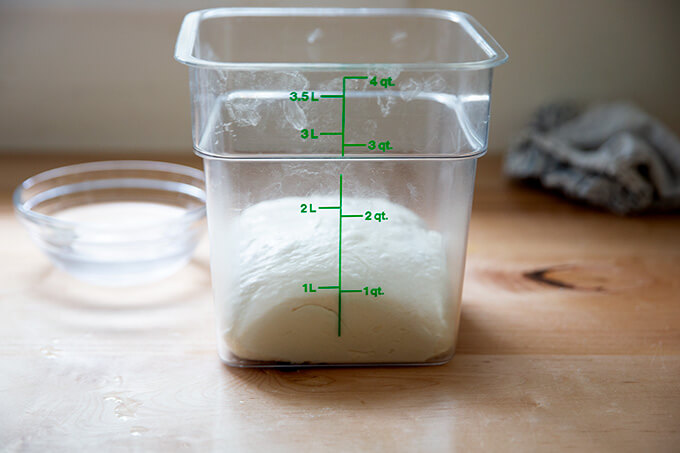
… it doubles in volume. (Note: If you don’t have a straight-sided vessel, you can simply let the dough rise in a bowl. I personally like using a straight-sided vessel because it allows me to see when the dough has truly doubled in volume.)
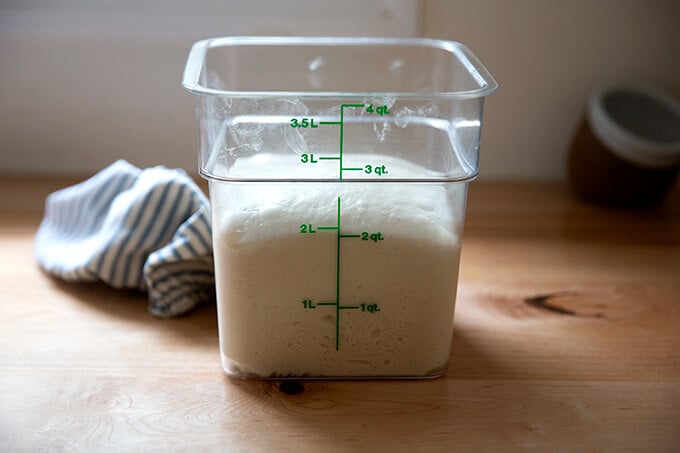
Then, punch down (deflate) the dough — I like to remove the dough from the vessel …
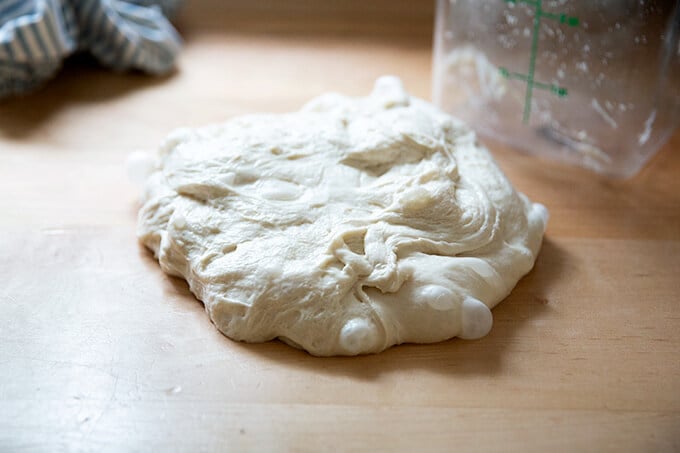
… and ball it up using wet hands.
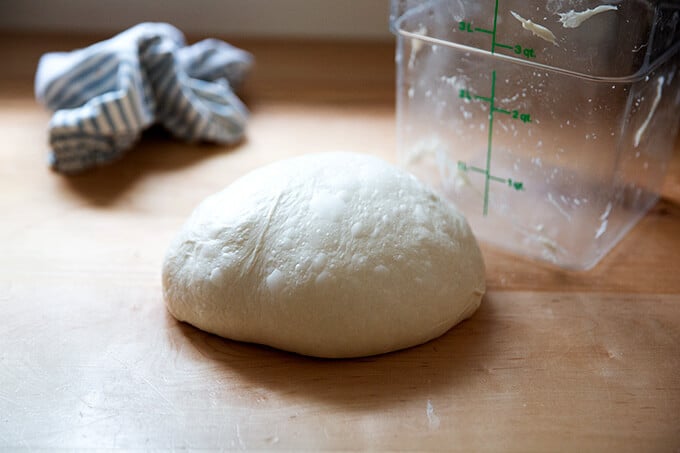
Return the dough to the vessel; then transfer to the fridge. (Another plus of using the straight-sided vessel is that it’s easier to store in the fridge than a bowl.)
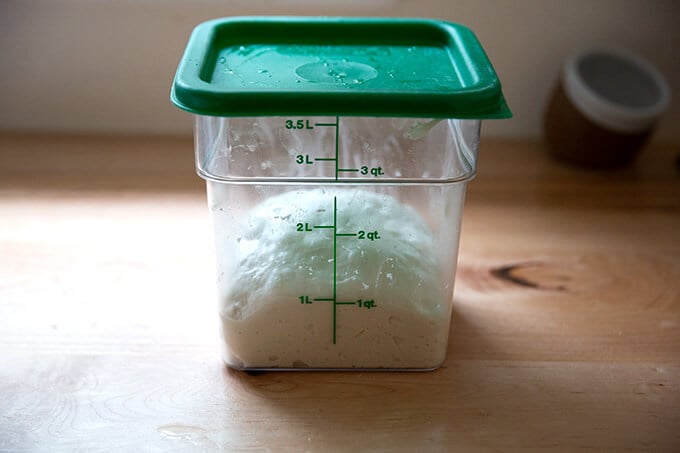
The dough will likely double in volume overnight in the fridge.
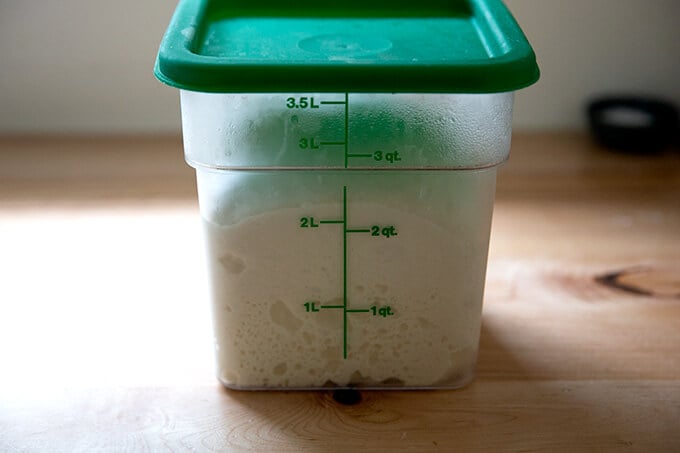
Remove the dough, turn it out onto a work surface…
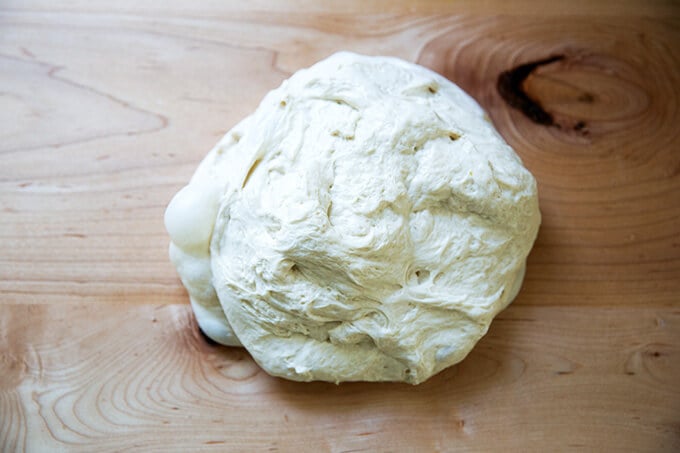
… then ball it up. (Note: This is where I deviate from the traditional ciabatta-making method. If I were to follow the traditional path, I would have simply patted that blob of dough pictured above into a rectangle; the cut it in half. I find I get a more open crumb when I preshape the dough.)
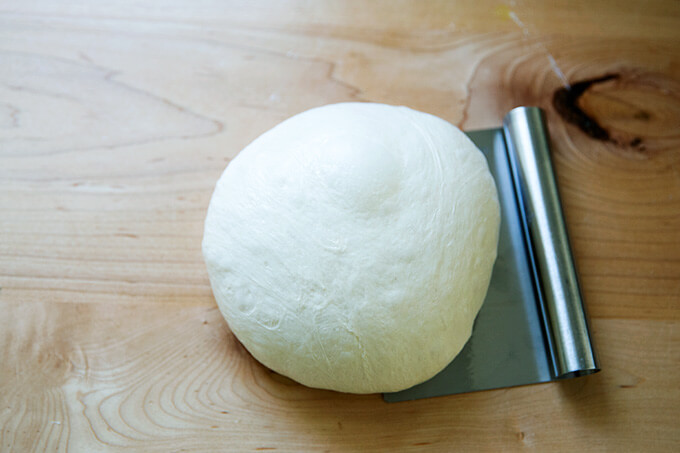
Divide the dough into two equal portions. Ball up each portion. I like to do this with very little or no flour — I find I get better tension with less flour.
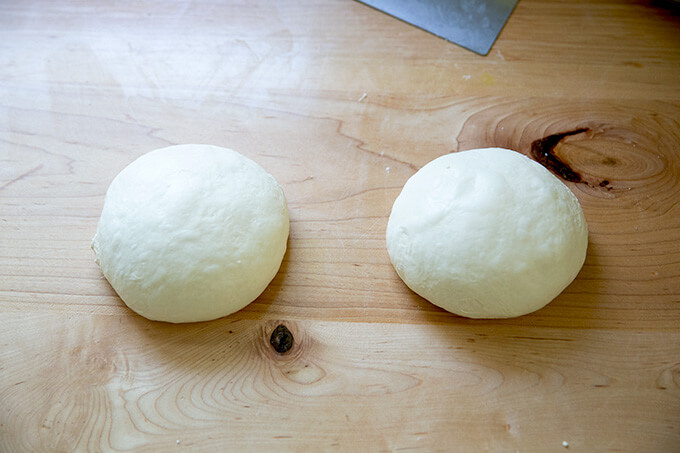
Sprinkle a work surface liberally with flour. Place the balls top-side down (the smooth side); then sprinkle the balls liberally with flour. Cover with a tea towel and let rest for 2.5 hours. Line a sheet pan with parchment paper.
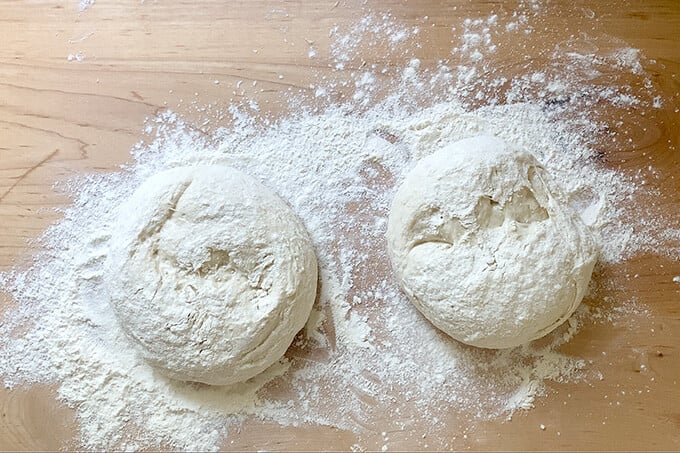
After the 2.5 hours… the dough balls will look like this:
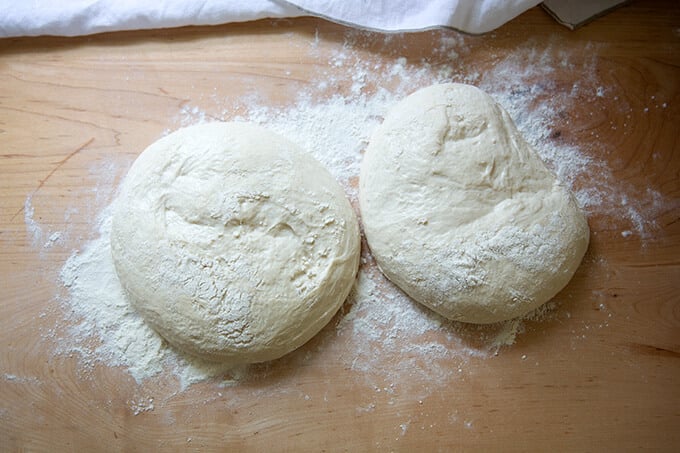
Turn the balls back over…
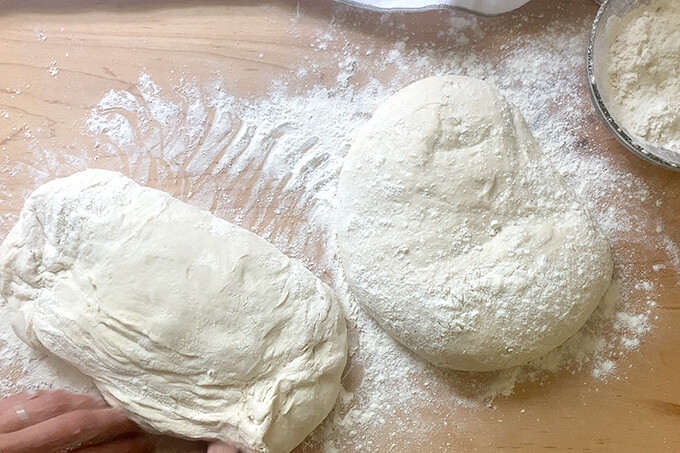
… then carefully transfer them to a parchment lined sheet pan.
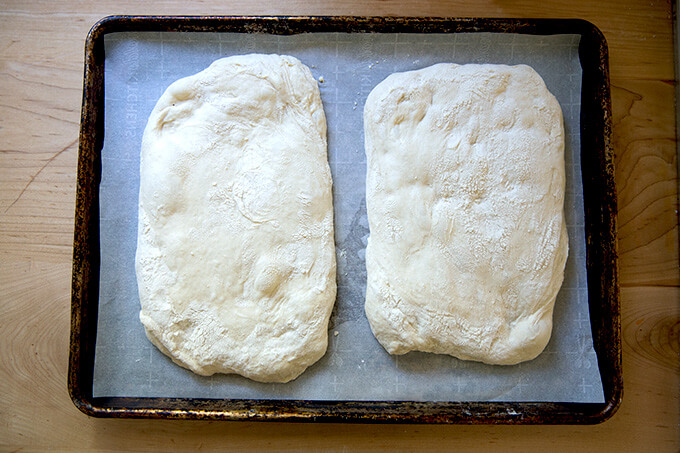
Bake at 425ºF for 20-25 minutes or until nicely golden:
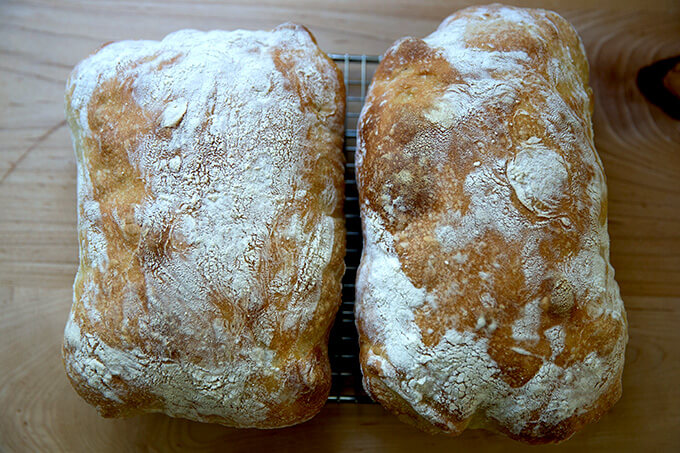
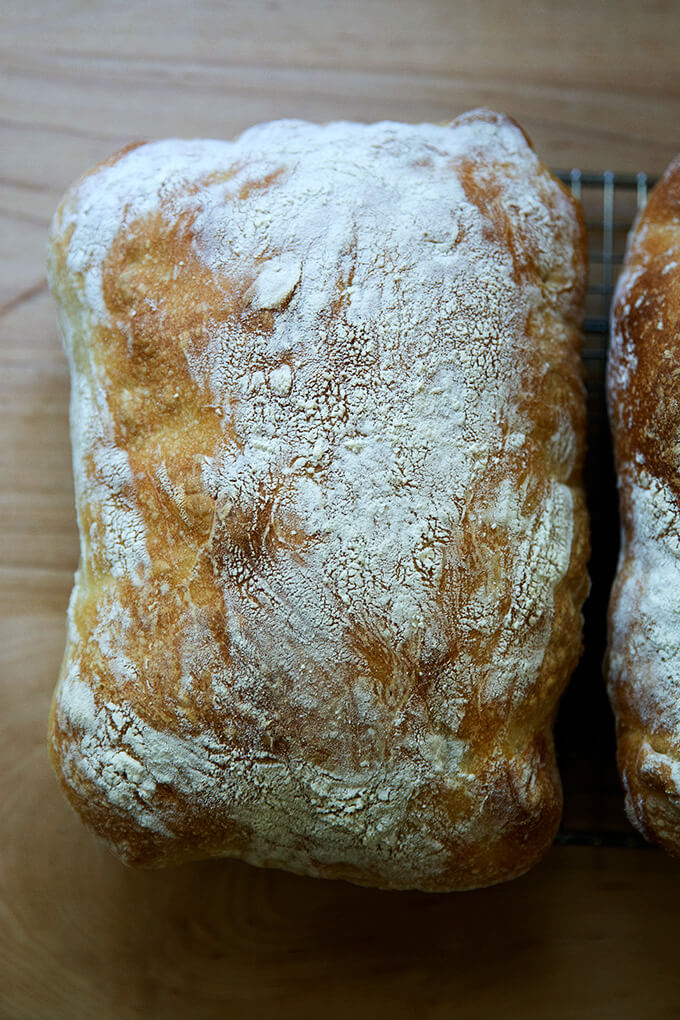
Let cool at least 20 minutes before slicing.
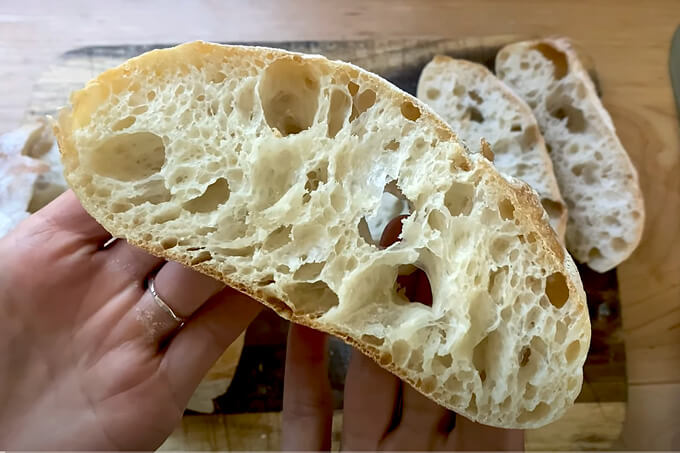
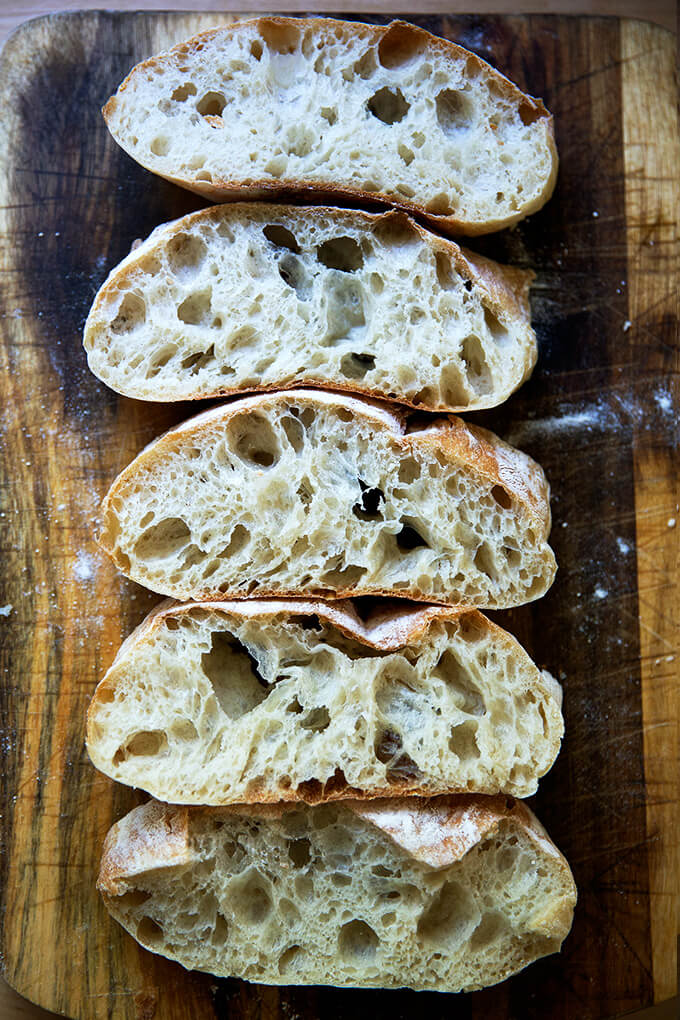
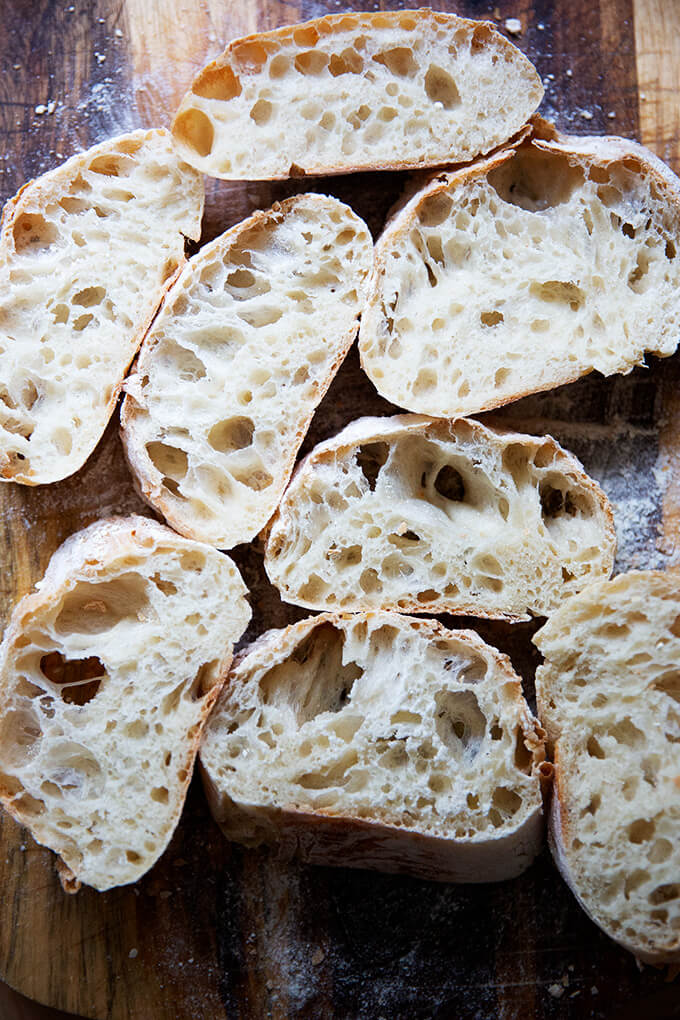

How to Make Ciabatta Rolls
Follow the recipe as outlined above or in the recipe box below until the step in which you remove the dough from the refrigerator; then, sprinkle a work surface with flour. Turn the dough out, sprinkle the surface with more flour, and pat it into a rectangle. (Note: This method, unlike above, follows a traditional ciabatta method — there’s no preshape or final shape. I prefer doing this with rolls for simplicity. It’s nice not having to ball up 8 portions of dough. If you wish, of course, you can ball up each round of dough.)
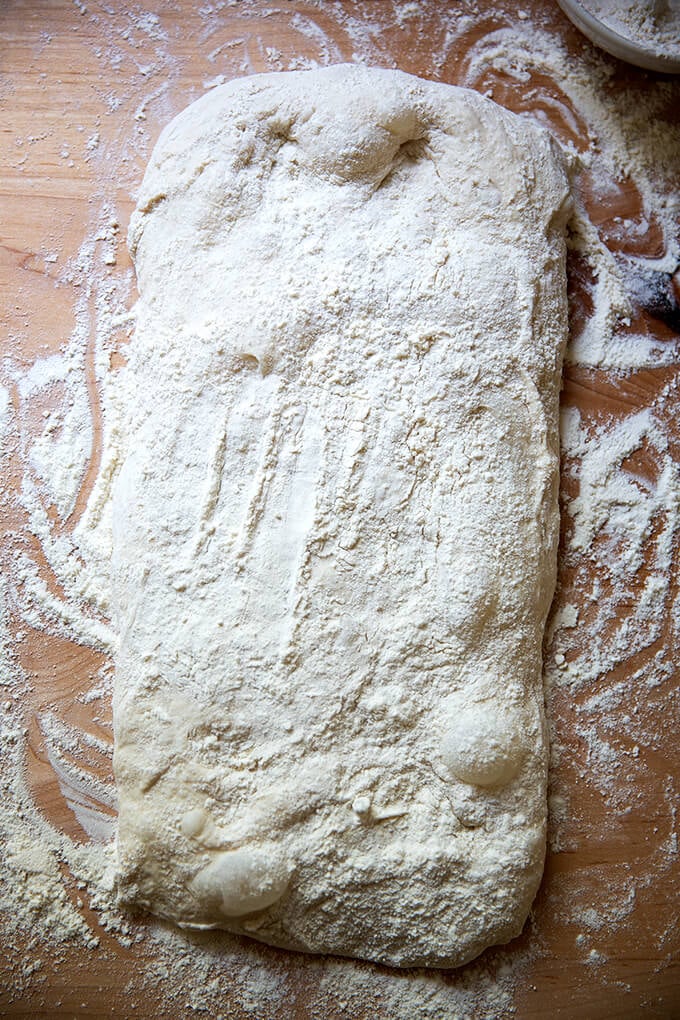
Divide into 8 portions.
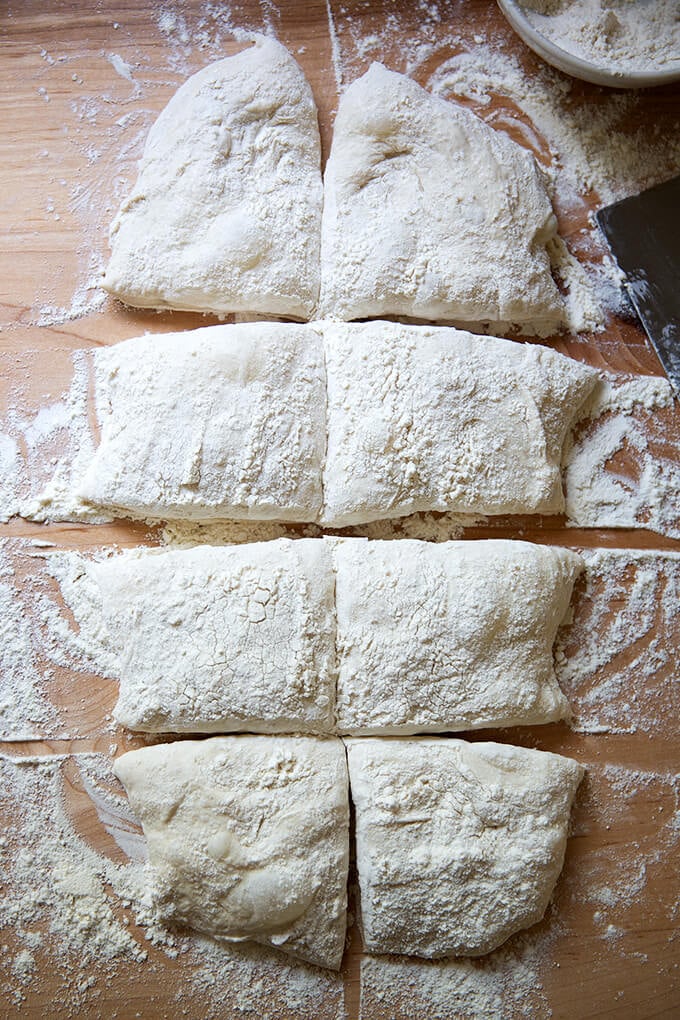
Transfer to a sheet pan, cover with a tea towel, and let stand for 2 to 2.5 hours.
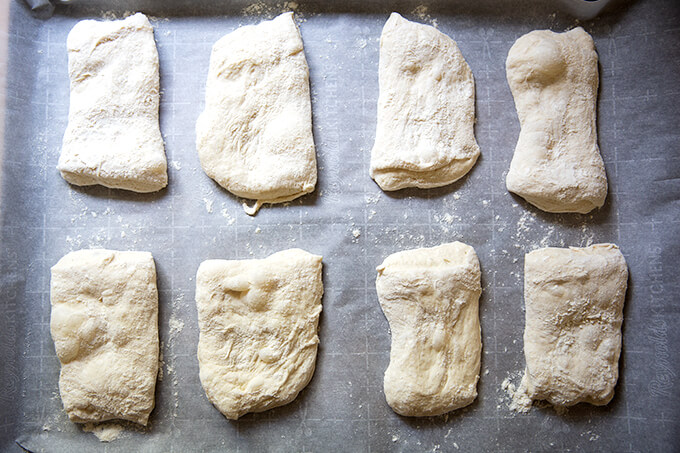
Transfer the pan to the oven, and bake at 425ºF for 20 to 25 minutes.
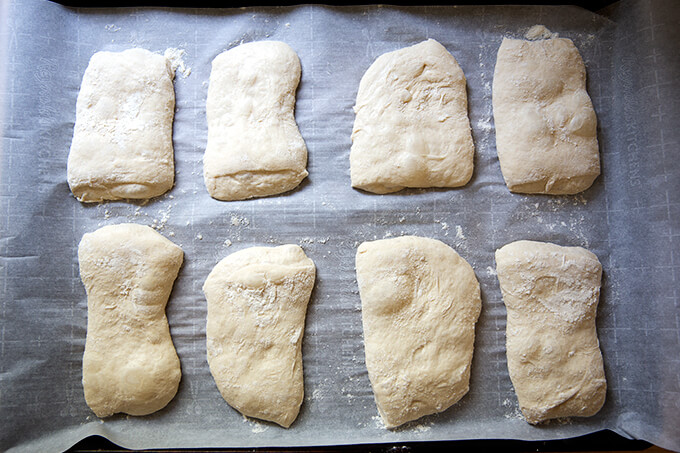
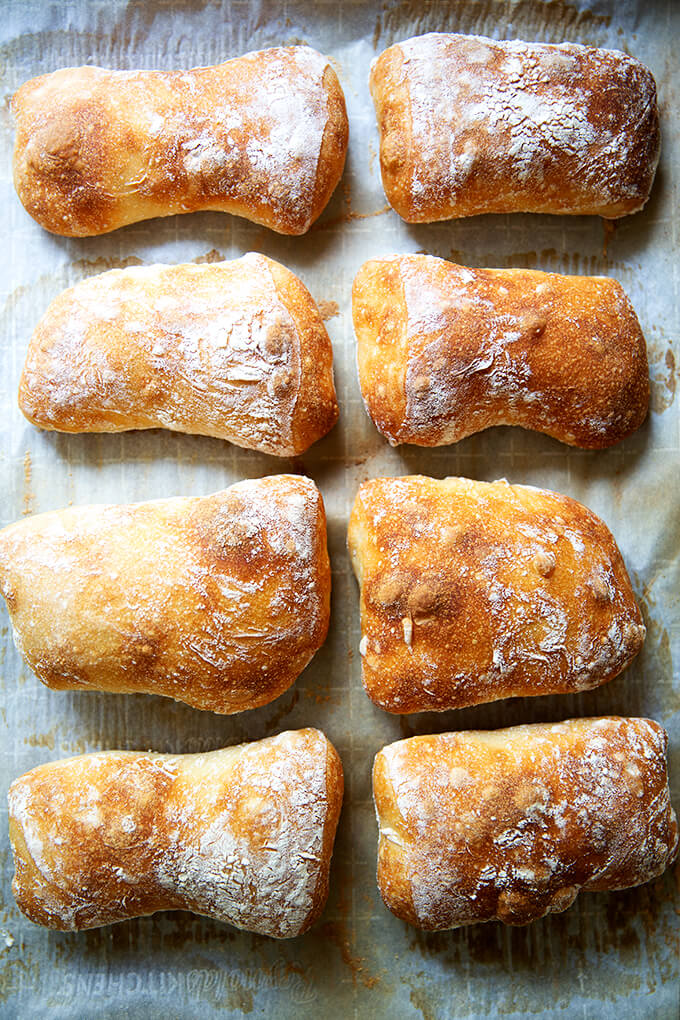
Let cool for at least 20 minutes before halving or slicing.
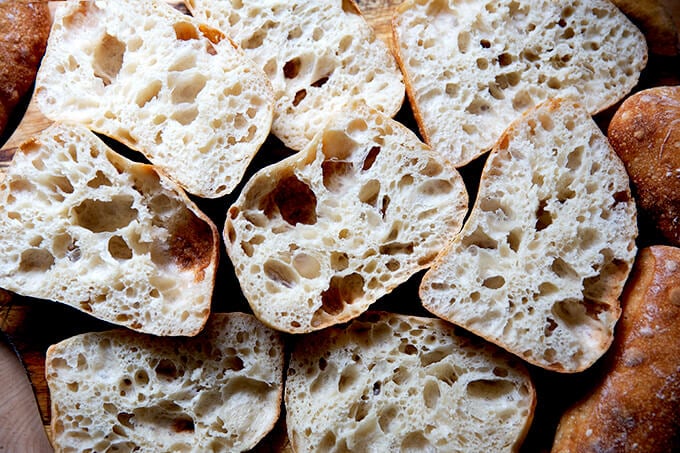
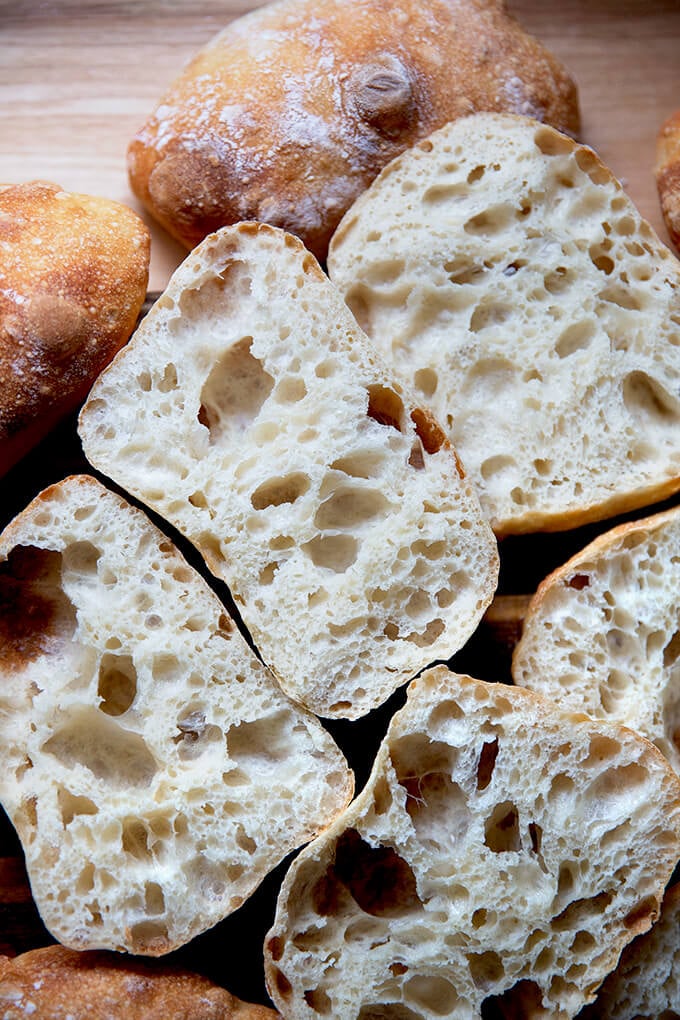
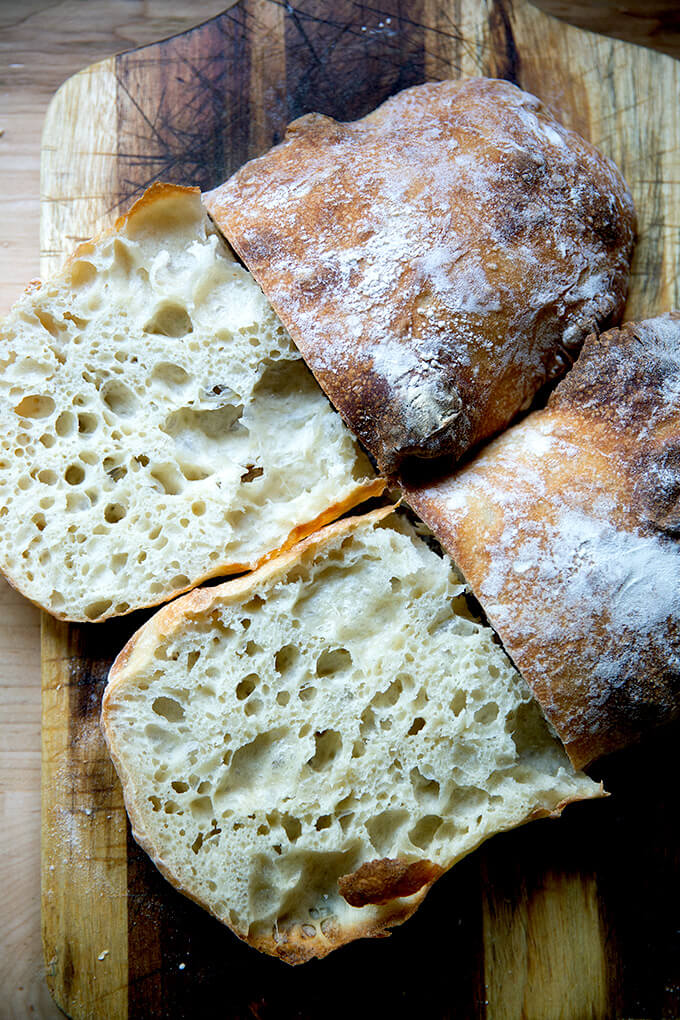
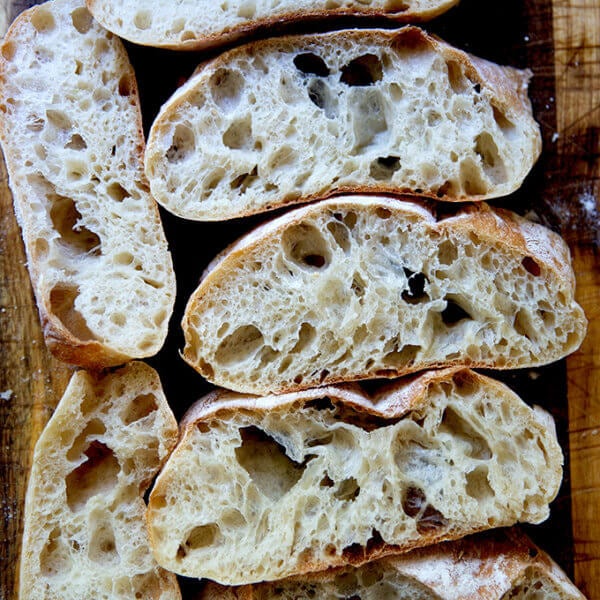
How To Make Fresh Homemade Ciabatta Bread
- Total Time: 24 hours 20 minutes
- Yield: 8 rolls
- Diet: Vegan
Description
This post will teach you how to make a crusty, open-crumbed loaf of ciabatta bread. It calls for making a poolish (a preferment), and it’s a very high hydration dough (82%), which means the dough will be wet and sticky. I highly recommend watching the video before attempting the recipe.
Notes:
- As always, for best results, use a digital scale to measure the flour.
- I have had success using all-purpose flour, but if you can get your hands on bread flour (I use King Arthur Flour Bread Flour, which is 12.7% protein), that is ideal, especially if you live in Canada or abroad. If you live abroad or if you live in a humid climate, this may take a try or two to get right — I suggest making it once as written; then reducing the water by 50 grams or so depending on your results.)
- I find a bench scraper particularly helpful for this recipe.
- I also really love using a straight-sided vessel (with lid) both for letting the dough rise and storing it in the fridge.
Ingredients
For the sponge:
- 50 grams (about 1/3 cup) all-purpose flour
- 2 grams (1/2 teaspoon) instant yeast, SAF is my preference
- 50 grams (about 1/4 cup) water, lukewarm or room temperature
For the ciabatta dough:
- 360 grams (about 1.5 cups) water, lukewarm or room temperature
- 12 grams (about 2 teaspoons) salt, kosher or sea salt
- 450 grams (about 3.5 cups) bread flour, see notes above
Instructions
- Make the poolish: In a large bowl, whisk together the 50 grams flour and the 2 grams (1/2 teaspoon) instant yeast. Add 50 grams water and stir with a spatula until combined. Cover the bowl with a tea towel or cloth bowl cover and set aside for 3 to 4 hours or until the dough’s surface is dimpled with holes.
- Make the dough: To the bowl of the poolish, add the water. The sponge should release from the bowl and parts of it, if not all of it, will float. Add the salt and stir briefly. Add the flour, and stir until you have a wet, sticky dough ball — dough will be very sticky. Cover with a tea towel or cloth bowl cover and let sit for 30 minutes.
- Stretches and folds: With wet hands, grab one side of the dough, and pull up and to the center. Rotate the bowl a quarter turn, and repeat the grabbing and pulling. Do this until you’ve made a full circle. (Watch the video for more guidance. I employ a “slap-and-fold” technique, which is helpful when handling these wet doughs.) Cover the bowl. If time permits, repeat this process three more times at 30-minute intervals for a total of 4 sets of stretches and folds over the course of two hours. If you are short on time, know that doing just one or two sets of stretches and folds is totally fine.
- Let it rise: Transfer the dough to a straight-sided vessel, if you have one, or leave it in the bowl if you don’t. Cover the vessel with a towel and let rise until doubled in volume. Punch down (deflate) the dough — if your dough is still in the bowl, you can deflate it using wet hands right in the bowl; if your dough is in a straight-sided vessel, it may be easier to turn the dough out onto a work surface and ball it up using wet hands to prevent sticking. Return the dough to the vessel, cover it with an airtight lid, and transfer it to the refrigerator immediately for at least 12 hours. The dough can remain in the fridge for as long as 48 hours.
- Portion and shape: (Note: This is where I deviate from traditional ciabatta bread recipes. See notes in the post above for the more traditional shaping method.) Turn the dough out onto a work surface. I prefer to do this step without flour, but absolutely sprinkle your surface lightly with flour as needed to make the dough manageable to work with. Using a bench scraper or your hands, shape the dough into a tight ball; then use the bench scraper to divide the dough in half. If you want perfectly even balls, each portion will way roughly 455 grams. Again, use the bench scraper or your hands to ball up each portion into a tight ball — see video for guidance.
- Proof: Sprinkle your countertop liberally with flour. Place the balls top-side (smooth side) down onto the flour. The seam-side will be on top now, and it may split open — this is fine. Sprinkle the top surface of the balls liberally with flour. Cover with a tea towel and let rest for 2.5 hours. After 2 hours of proofing, heat the oven to 425ºF.
- Line a sheet pan with parchment paper. When the dough has finished proofing, gently flip each ball over — I find a bench scraper to be helpful here. Then use both hands to stretch each ball out gently into a rectangular shaped “slipper”. Transfer to the prepared pan.
- Bake for 20 – 25 minutes or until the loaves are golden all around. Remove pan from oven. Transfer ciabatta rolls to a cooling rack. Let cool for 20 to 30 minutes before slicing.
- Prep Time: 24 hours
- Cook Time: 20 minutes
- Category: Bread
- Method: Yeast
- Cuisine: Italian, American
This post may contain affiliate links. Please read my disclosure policy.

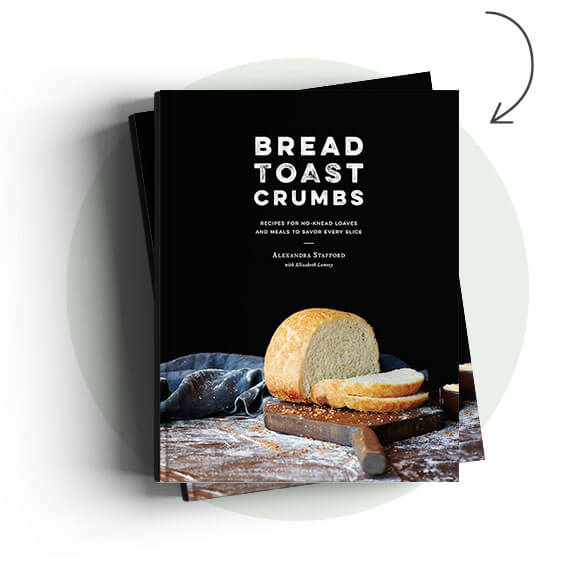




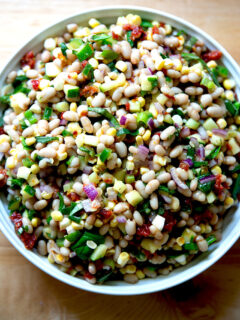
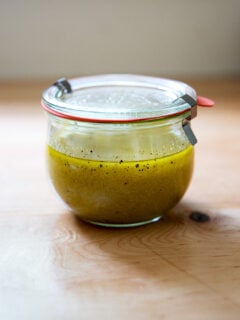
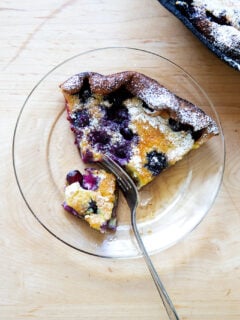


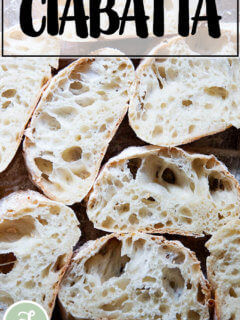
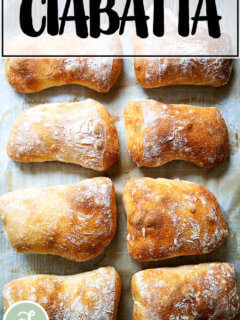
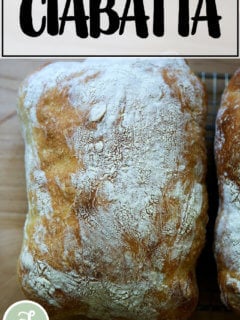
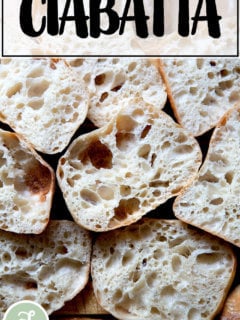
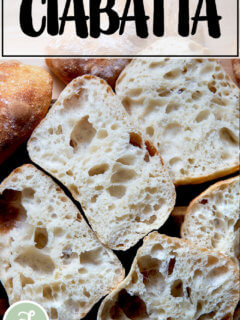
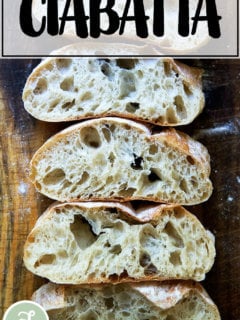
260 Comments on “How to Make Fresh Homemade Ciabatta Bread”
I’VE MADE CIABATTA BREAD MANY TIMES FROM THE RECIPE OF 18 HOURS TO RISE I CERTAINLY WILL GIVE YOUR RECIPE A TRY AS SOON AS POSSIBLE. MY ONE QUESTION IS, IS THERE A PRESERVATIVE I CAN USE IN THE RECIPE TO KEEP THE BREAD FRESHER LONGER?
Hi Lou! I hope you love the ciabatta. I do not, unfortunately, know how to recommend using a preservative in the dough as I’ve never done that. My suggestion would be to freeze one of the loaves; with the other, store it in an airtight bag at room temperature. Always toast or reheat day old bread before serving.
YAY!!! I’ve been waiting for this one!! This will be my weekend bake. Will report back. 😀
Oh YAY!! Tina, can’t wait to hear how it turns out.
Hooray, Ali! Congratulations on your perseverance and ultimate success. I just baked two loaves of your flax quinoa bread which is a staple for morning toast in this house. As soon as I have room in the freezer, I will be trying this inspired bread. Can’t wait! Might not! 😊
Thank you, Leslie!! So great to hear about the quinoa-flax bread, too. That is my favorite for toast. Hope you love the ciabatta. Thanks for writing!
I love your explaining. And I love high hydration doughs! I’ll try these soonest!
Hope you love them, Dana!
Trying this today and I have a few questions!
1) Does the water need to be a specific temperature? I went with lukewarm like your other bread recipes.
2) Is 12g table salt acceptable? I know you often use kosher and couldn’t quite tell from the video but only had table salt on hand…hopefully find doesn’t turn out too salty!
Hi! I’m likely not getting you in time … hope it’s all going OK 🙂
1. Lukewarm water is perfect. I will make a note. I often have a pitcher of water I leave out at room temperature to use for bread. This time of year, because it’s so hot, sometimes I’ll even use cold tap water — dough temperature adapts to the ambient temperature very quickly, so while lukewarm water is great in the winter to give the yeast a boost, in the summer, it’s not as important.
2. 12 grams of salt definitely feels like a lot, and I do use kosher salt. Table salt might make for a saltier bread … I hope it’s not too salty. I will make a note as well about the salt.
Hope it turns out well!
Just reporting back that table salt worked out fine! I would just hold back more water next time since I went with AP flour…still tasted great though 🙂 Thank you for sharing so many lovely bread recipes!
Great to hear! Thanks so much for reporting back and thank you for your kind words 🙂 🙂 🙂
Question: In step 4 do you have an approximate time for the first bulk fermentation before putting in the fridge? I know it probably varies a lot but just trying to plan when I can make this based on timing involved. With your sourdough ciabatta rolls you say 4 hours plus at this point and I’m assuming it may be about the same? Can’t wait to try it. You got me started on the sourdough ciabatta rolls which are perfection and get rave reviews. Almost afraid to attempt the bread because it can’t be as foolproof and great as the sourdough rolls. Between your glass bowl bread and the ciabatta rolls, I could be set with my favorite breads forevermore!
Thank you for all your great breads!
Hi Carolyn! Great question and great to read all of this. Thanks for writing!
The bulk fermentation will vary in length depending on the time of the year, but it will likely be around 2 hours after the stretches and folds are complete. Yeast is SO powerful. Even in between the sets of stretches and folds, you will feel the dough starting to grow.
Thank you for your kind words 🙂
Hello, I tried the recipe and had success! My family loved it. I did have some problem getting a tight ball with the bench scraper and ended up using my hands, but when proofing it spread out quite a bit. This didn’t seem to effect the bread when it came out – it was soft/chewy and great holes! Thank you for the recipe, I will be making it again when the heat dies down a bit this summer!
Oh yay! This makes me so happy, Leslie! Thanks so much for both making the recipe and sharing your results. Shaping the dough using the bench scraper is where I anticipate people having a bit of trouble — the dough is SO wet. I also worry that certain work surfaces will be harder to work on. For instance, I have wooden countertops, but they have some sort of sealant on them that makes them almost nonstick. I brought two batches of dough to my parents’ house in CT this weekend and I used a wooden board to divide and shape the dough, and it was a little trickier to get the shape I was looking for. I think marble or granite would work great as would a large Silpat mat … I should add some notes.
In any case, I’m so happy this was a success. Thanks again for writing. Stay cool!
I am in the process of making this, however I did not see where I was suppose to let it rise in the vessel before putting it in the refrigerator! Help please what should I do? I only watched the video my bad… I printed out the recipe this morning.
Hi! It should be fine. Did the dough double in the fridge overnight? If so, simply turn it out and proceed with the recipe; if not, let the dough rise at room temperature until it doubles; then turn it out and proceed with the recipe. Let me know if you have any other questions!
I am in the process of making this, however I did not see where I was suppose to let it rise in the vessel before putting it in the refrigerator! Help please what should I do? I only watched the video my bad… I printed out the recipe this morning. Update! I just with it figured what the heck I already messed up. Well I made one loaf and 6 rolls, OMG best ever! Thanks Alexandra
Wonderful to hear this, Susan!! Thanks so much for writing back. I hope you saw my note to your previous comment that it should have been just fine … glad it was!
Thanks so much for brilliant instructions. Mine looks almost as good, but less holes on the bottom. Why? Also flours vary enormously. In Australia I used a “bread flour” and noticed in another recipe they use half bread flour and half OO pizza flour. Any comment about flour variations? It’s the first time I’ve ever achieved an oven spring, so I’m thrilled.
Great to hear!
OK, a couple of questions: Do you know the protein content of the bread flour you used? Did you make rolls or the two larger loaves? Did you find the dough to be very wet and soupy? Or did it come together in a nice cohesive ball?
Hi Ali, The protein content of the bread flour was 7.2 g per 100g. I made 2 loaves and felt maybe I didn’t stretch them out enough. The dough was a bit wet to handle so I did add some of the 00 flour which has a protein content of 11 g per 100g. For memory my normal un bleached bread flour is around 11 g per 100g, but I had run out. I will definitely try again with the higher protein flour. What is your protein content? Thanks again.
Hi! My bread flour is 12.7%. I think you could consider reducing the water a bit — if it’s too wet, the dough won’t have the strength to create those big holes, so you’ll get a tighter crumb. Good luck with the next go around!
Thanks for sharing such a detailed post! I tried this ciabatta out today in loaf form and sadly think I ran into your tunnelling issue. My loaf was a bit flat, the bottom seemed quite dense and the top had large pockets like a tunnel.
My dough was looking/feeling great so I’m not sure what happened…I may not have let it proof long enough after taking it out of the fridge. Also my dough didn’t double in size overnight in the fridge for some reason (maybe my fridge is too cold?!).
Just curious, I notice that you don’t use any form of steam when baking the ciabatta…is there a particular reason for this?
Hi Stephen! Bummer to hear this. Do you recall how long you let it proof after you removed it from the fridge? That was the biggest culprit for me in regard to the tunneling.
Not doubling in the fridge is OK, especially since it doubles once at room temperature before being transferred to the fridge.
I don’t use steam because I don’t ever find it makes a huge difference, but you absolutely can use steam if you like to.
Hi. Thanks for the reply. I let it proof for around 1.5 hrs…it seemed very bubbly and I was worried about over-proofing it, but perhaps I was too hasty! Upon inspecting the crumb inside I saw lots of tears/rips and large pockets which does indicate that it probably was under-proofed and that it may not have had a strong enough gluten network (the hydration may also be a bit high for the flour I’m using in the UK).
I will definitely try again and adjust a few things.
Hi Stephen! Thanks for reporting back. Yes, I think it likely was underproofed if you’re seeing lots of tears and rips. And I would definitely reduce the water amount if you are in the UK. With this sourdough pizza recipe, lots of people in the UK I troubleshoot with find success as soon as they reduce the amount of water they are using. I might try using 310 grams water next time around.
What time of day would you recommend starting this to correctly time the overnight fridge rest?
I would say morning or midday. This will get the dough in the fridge before or by dinnertime, and the dough will have plenty of time in the fridge before the next steps.
It is so, so nice to finally have a sourdough-like recipe without needing to maintain a starter. I have a feeling this will be made a lot in our house! Thank you for all the work you put into developing this, Ali.
Hope you love it! I think this poolish method could be used in place of many recipes calling for a sourdough starter. Hope it works out for you!
I’ve made a lot of bread in my years of baking. And I’ve had many delicious successes. But this ciabatta recipe might just be the best of them all. I love Bread Toast Crumbs and every recipe you’ve posted on your blog. Thanks for sharing all of your cooking and baking here with all of us who love your blog. To everyone reading this, if you haven’t tried this Ciabatta loaf, please do! Lu
Lu, this means the world 🙂 🙂 🙂 Thank you so much. Your ciabatta photo was stunning!!! Thanks so much for writing and for always being such a positive
spirit. Happy Happy Fourth!!
Can you use all purpose flour? If so how much would you decrease the water. Can you use dry active yeast ?
Hi! And yes.
Kimberly, where are you located? A humid climate or dry?
If you are in a dry climate, I would try the recipe as is, otherwise, consider reducing the water by 50 grams.
Active dry yeast should work just fine. Just make sure your poolish is dimpled with holes before proceeding.
Let me know if you have other questions!
Hi Ali, This is Maryam from Egypt I will try the recipe tonight and keep U informed, I just have a question
Can I freeze one of the balls, if so what about its baking?
Thanks in advance
Hi Maryam! It’s been too long. Hope all is well 🙂 🙂 🙂
Yes, absolutely you can freeze one of the balls … sorry for the delay here. Hope I’m getting to you in time. You will want to freeze it after the first rise. At the point in the recipe when you punch it down and are about to transfer it to the fridge, transfer it to the freezer instead. Thaw at room temperature or in the fridge overnight.
Let me know if you need any clarification!
My dough has been really soupy during the folding process. Do I just add more flour?
Hi Vanessa! Apologies for the delay here.
Questions: Are you using a scale to measure? What type of flour are you using? Do you live in a humid environment?
I live in a dry climate (I’m in California). I weighed my ingredients. I had a lot of problems handling the sticky dough, it wouldn’t get elastic enough. I used AP flour for the poolish and bread flour as directed. I ended up adding more flour to it so I could handle it better. My ciabatta didn’t come out all porous and it stayed quite pale even after some after baking (probably dusted it with too much flour) but it has a nice chewiness. We’re still going to enjoy it! I just made some sandwiches with fresh mozzarella, tomatoes, pesto, and cured meats.
OK, I think next time around, if you reduce the water by 50 grams, you’ll have success. Out of curiosity, what brand of flour are you using?
It sounds as though it’s just too much water given the type of flour you are using. With less water, you’ll be able to get that elasticity and strength during the stretches and folds, which will lead to a more porous crumb. When there’s too much water, those big air pockets won’t form.
Glad to hear the bread is still chewy and edible and sandwich-able 🙂
I was waiting for this recipe ever since you announced you were working on it. I made it with great success and loved it. Thanks for sharing a very detailed recipe and your hard work to perfect it!
Oh yay!! Sandra, so nice to hear this. Thanks so much for writing 🙂 🙂 🙂 And thank you for your kind words.
Hi Alexandra. I went into my 3rd batch of this wonderful ciabatta feeling very confident. It proceeded as with previous 2 batches but guess what? I got the giant pita effect just like you talked about in your blog. Thought I did everything exactly the same, the only difference being it was probably warmer in the house than before. Mine have always been wetter than yours look with less structure in the forming but I’ve had great end results anyway – until now. The last rise after refrigeration that you said made the difference was 2-1/2 hours just like before so I’m not sure where I went wrong. I happen to love the crust so I’ll still make use of my ballon loaves!
Hi Carolyn! Apologies for the delay here … I’m away from home this week, but I also was trying to do some more research as to what might be going on… I’m sorry about your giant pita!
My only thought is that because the dough is wetter than mine and because the house is warmer during these summer months, you should cut the water back slightly. Try holding back 50 grams and see if that makes a difference.
It’s possible that the dough just didn’t develop enough strength, so when it rose, even after the long proof, the gas created just blasted through the dough structure.
Keep me posted if you give it another go! Also: are you using bread flour or ap flour?
Thanks for your reply! Going for batch 4 today and will try cutting back the water 50g as you suggest. I am using King Arthur bread flour.
P.S. Lovely pics on Instagram of your sisters wedding! The children are all adorable!
OK, fingers crossed, Carolyn!! And thank you for the kind words re the wedding … it was such a fun/emotional weekend 💕💕💕💕
Thank you, Thank you, Thank you!
This is the Best Ciabatta recipe ever. Fantastic instructions and video. Love all you do! Again, thank you!
Oh yay! Great to hear this, Cheryl 🙂 🙂 🙂 And great to hear from YOU! Hope all is well.
I made the rolls twice, both times with KAF bread flour, SAF yeast and weighing the ingredients. Both times I did not get those lovely holes. I got great rolls with a lots of smaller holes. The first time I did not let the dough rise before putting in the frig, so I let it rise (double) after removing from the frig, then continuing as written. The second time I made them I started earlier in the day so I could follow the recipe as written. The rolls had the same texture as the first time.
What can I do differently to get those larger holes?
Thanks
Hi Adele! Sorry to hear this! Question: when making the rolls, are you shaping each portion into a ball? Or are you turning the dough out, cutting it, and transferring it to a sheet pan?
One thing you might want to try is a longer fridge proof. So, let it rise till it doubles, punch it down, then transfer to the fridge for at least 24 hours.
I did not form the rolls into balls, but just cut up the turned out dough.
I will try a longer frig proof next time. Thanks
Ok, that’s good to hear. I find I get a more open crumb with the rolls when I do not shape the portions into balls. I think a longer fridge proof will help.
This is a great recipe. I did take your advice and use less water as I made these in Bombay. This was the second time I made them and today they turned out even better than the previous time.
Wonderful to hear this, Nita! Thanks so much for writing and sharing your notes 🙂
Hi Ali….followed instructions exactly but even after 4 hours my poolish had only small dimples, did not look like yours. Dimples were not pronounced like yours. Added water and salt and it was just super watery then, no substance to it.
It is about 77 degrees in my house in Georgia, ac is on of course, about 44% humidity. Water was luke warm,,,,,,could I go with warmer water and or put it in my oven which has a proofing setting?
Hi Stephen!
OK, questions: are you using instant yeast? And is it fresh as in newly or sort-of recently purchased?
Are you using a scale?
I wouldn’t go warmer than lukewarm water for fear of killing the yeast. You can definitely use the proofing setting in your oven.
When you did the stretches and folds, did the dough develop some strength and elasticity? Or was it very watery still?
After putting the dough in the frig for 12 to 48 hours, do I bring it back to room temp before proceeding?
Thanks
Hi Barbara! No need to bring it to room temperature!
Hi Ali, just wanted to let you know that I LOVED the ciabatta! I’ve been baking forever but a traditional ciabatta is so fussy and labor-intensive that I don’t make them much anymore. This is amazing, so straight forward and much easier to handle. My dough never formed the nice cohesive ball yours did but it was still easier to handle than other recipes I’ve followed. Thank you for your hard work and very easy to follow, thorough directions. I will be making this again and again!
So wonderful to hear this, Kathy! Great to hear you had success despite the dough not forming a ball — environment might be playing a role here. Thanks so much for taking the time to write!
Hi Ali, I started my first loaf last yesterday, I don’t think my first try was very successful. I was excited about the poolish, it looked just like yours in the video. The problem came after the next steps. My dough never really game together in a smooth ball, It was very wet. I plugged through and got it into my container for the over night rise. I will pull it out this morning and continue the process. If it’s still too wet to make a smooth ball, would you suggest adding more flour?
Hi Julie! I wouldn’t add more flour, but I would be generous with the flour when you are shaping — if it doesn’t form a tight ball, it’s OK.
Sorry for the trouble with this one!
Questions: are you using bread flour or all purpose? Do you live in a humid environment? And are you using a scale to measure?
Hi Ali, thank you for the speedy reply.
Yes, I always use King Arthur bread flour
I do live in the Pacific Northwest and the rainy season has begun
Yes I do use a scale to measure.
I did follow through and baked the dough. It did not bake to a lovely brown color more like tan. The texture was not at all like yours. I do plan to give it another go next weekend. Any suggestion for my next attempt?
I was wondering about using 00 flour?
Ok, great to hear all of this. I think it will simply be a matter of reducing the amount of water. I would hold back 50-75 grams of water. You can always add it back in slowly if the dough seems too stiff. I would reference the video for texture.
I don’t think you should switch to 00 flour just yet. That will make for an even wetter dough.
Regarding the color, you could try cranking up the oven to 450ºF next time around.
Thanks, I will give this a go and let you know how it goes.
Hi Ali, I had another go this weekend. I reduced the water by 50 grams and baked at 450. My crumb was excellent. The crust was not as crispy as I would have liked. Over all I think it was a good success! Is it possible to over bake? I’d like to get that hard crust. I do have convection option for my oven. Would you recommend convection baking?
It took me a couple of tries making your focaccia, it’s a huge favorite at our house. Thank you for all of your videos, I just love watching. I love how informal they are, just another day in the kitchen with the kids at home.
Great to hear this, Julie! Thanks so much for reporting back and thank you for your kind words … means a lot 🙂 🙂 🙂
Regarding the crust — I don’t think you can overbake it. It’s such a high hydration dough, that the crumb will still be moist if you bake the bread 5-10 minutes more to get the color/crustiness you are after. I generally don’t advise baking with convection for bread only because it causes bread to brown more quickly, which can be misleading and may cause someone to remove a loaf of bread from the oven before it is actually cooked. That said, now that you have a baseline of what to look for, I think you could give it a shot. Try it next time and just keep an eye on it every 5-10 minutes to ensure it’s not browning too quickly. Good luck!
Hi Ali, I replying to this response because there was not a reply button to your latest reply to me.
I do have a question about using the proof option on my oven. The proof temp is 100 degrees and I am concerned that is too high. It is Oct here in the PNW, the temp in my home hovers around 67 degrees. So, I am conflicted about leaving it out on the counter…using the proof option or just putting in the oven without the proofing option. Any advise would be appreciated. thanks.
Hi Julie! The proofing setting might be just fine as long as it indeed stays at 100ºF or below. What’s interesting is that when you leave the oven light on in the oven, it’s too hot (definitely above 100ºF) for the bread — I’ve tried that and my dough overfermented. But I know lots of people that use the oven proof setting on their ovens with success, so I think it’s worth giving it a shot. I would just take a peek after 30 minutes — oven the oven, touch the bowl, just make sure it doesn’t feel too hot. Hope that helps! And apologies if I am getting to you too late.
Haven’t tried it yet but I will today probably. My question is this, can I substitute dry active yeast for instant by adding a little sugar in the first step?
David
Hi David! Yes, absolutely, go for it!
Oh GAWD! Yes it does. You’ve turned me into a bread baking fiend, Ali! Are you married? Lol
🤣🤣🤣🤣🤣 I am, sorry! But so happy to hear you’ve become a bread-baking fiend 🍞🍞🍞🍞🍞
My rolls had chewy crusts with soft, fine crumb but no holes. Every step was fine until the last – resting the cut rolls prior to baking. I used Gold Medal bread flour, only 350g of water due to the rainy weather in Seattle. Dough looked and felt very sticky but workable during the folding steps with wet hands. It sat in the frig for 18 hours and it was puffy and light. After cutting into rolls, they rested for close to 4 hours since my kitchen was a cold 59-60 degrees. Can you explain why the 2-1/2 hour rest and how this time may vary in a cold or warm kitchen? Did I over-proof? (You had recommended a longer proof time for focaccia since the dimpling was not retained during baking. Perhaps this doesn’t apply with ciabatta dough?)
Hi Wendy! Bummer to hear this.
Four hours for the rolls does seem like a long time, and it’s possible that the dough did overproof, which would have caused those air pockets to collapse.
It is a very fine line between 2.5 hours and more or less time — I found that less than 2.5 hours would cause me to bake those hollow loaves. I didn’t push the second proof much father than 2.5 hours, so it’s possible that your dough did just overproof.
Part of me wonders if the flour is making a difference. KAF bread flour is slightly higher protein than Gold Medal, but only very slightly.
It’s possible the environment is playing a role, too.
I would try again, if you are up for it, with a shorter second proof, especially if the dough was puffy and light when you pulled it out of the fridge — it’s those air pockets you are trying to preserve. Maybe for you, the second proof is even shorter than 2.5 hours.
My kitchen is very cool right now… I’ll experiment today and report back in the next day or so.
Hi Ali,
I just want to start by saying I absolutely love your recipes. I’m a beginner bread bakers and I’ve made a couple of your recipes with great success. I’m in the middle of this recipe and I find that my dough is far too wet and not elastic enough to fold when it comes time to fold it. I am using the flour mix in the recipe but I’m wondering if the particular brand I am using is the issue. It’s “Farmers ground organic half white” bread flour.
It’s a bit more coarse than AP flour. I’m going to try and finish the recipe as best I can but I was wondering what your suggestion would be to avoid this next time. Should I use a different brand or reduce the amount of water? Thanks!
Hi Victor! Apologies for the delay here. The issue most likely is the flour. I have used that Farmer Ground Flour — they’re an Upstate New York brand not too far from me — and it is wonderful (aromatic and tasty), but it is stoneground flour so it will behave a lot differently than commercial bread flour. This is because there is bran and germ present in the flour, which makes it trickier for the gluten to form a strong network, whish is why you had the wet and non-elastic dough.
Question: are you using a scale to measure?
Regarding next time, I would suggest using mostly commercial bread flour, such as King Arthur Flour bread flour, and just a little bit of the FGF. You could start with 75 grams of the FGF or something like that. Once you get the hang of the recipe, you cam increase the amount of FGF you are using.
Hope that helps!
Hello. I’m meeting friends in Asheville for the weekend and want to bring this with me for a Sunday meal. Since I’m leaving on Friday – would you recommend that I bake the bread and then freeze it, or time it so that I am baking it on Friday morning and then not cutting into it until Sunday?
Thank you!!! And I’ve got peasant bread in the oven and the roasted butternut squash on the stove!
Hi Anne! It might be easier on you to bake it; then freeze it. You can pull it out of the freezer just before you leave. It might actually stay fresher that way. As always, reheat it before serving … you know this of course 🙂 🙂 🙂 Safe travels and enjoy Asheville… dying to get there!
So nice to hear about the peasant bread and roasted butternut squash. Thanks for writing!